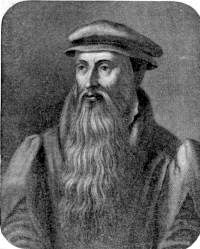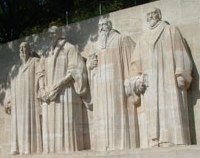(See also: Disambiguation John Knox – and wikipedia’s Human name disambiguation pages)
Linked with The International Reformed Center John Knox IRCJK, with John Knox and women, and with Découvert un trésor des TPG Genevois, le Site NonOfficiel des tpg SNOTPG – le Site NonOfficiel des TPG.
John Knox (c. 1510 – 24 November 1572) was a Scottish clergyman and leader of the Protestant Reformation who is considered the founder of the Presbyterian denomination. He was educated at the University of St Andrews and worked as a notary-priest. Influenced by early church reformers such as George Wishart, he joined the movement to reform the Scottish church. He was caught up in the ecclesiastical and political events that involved the murder of Cardinal Beaton in 1546 and the intervention of the regent of Scotland, Mary of Guise. He was taken prisoner by French forces the following year and exiled to England on his release in 1549 … // … On his return to Scotland, he led the Protestant Reformation in Scotland, in partnership with the Scottish Protestant nobility. The movement may be seen as a revolution, since it led to the ousting of the queen regent, Mary of Guise, who governed the country in the name of her young daughter, Mary, Queen of Scots. Knox helped write the new confession of faith and the ecclesiastical order for the newly created reformed church, the Kirk. He continued to serve as the religious leader of the Protestants throughout Mary’s reign. In several interviews with the queen, Knox admonished her for supporting Catholic practices. Eventually, when she was imprisoned and James VI enthroned in her stead, he openly ridiculed her in sermons. He continued to preach until his final days … (full long text).(More on wikipedia: 1) Early life, 1510–1546, 2) Embracing the Protestant Reformation, 1546–1547, 3) Confinement in the French galleys, 1547–1549, 4) Exile in England, 1549–1554 , 5) From Geneva to Frankfurt and Scotland, 1554–1556, 6) Return to Geneva, 1556–1559, 7) Revolution and end of the regency, 1559–1560, 8) Reformation in Scotland, 1560–1561, 9) Knox and Queen Mary, 1561–1564, 10) Final years in Edinburgh, 1564–1572, 11) Legacy, 12) Selected works, 13) Notes, 14) References, 14.1) Primary sources, 14.2) Secondary sources … ).
left: John Knox – Scottland-England (1505-1572) – right: eternally in Geneva
. . .
. . .
.
He says: A man with God is always in the majority … and: Quhat have ye to do, said sche [Mary Queen of Scots], ‘with my Mariage ? Or quhat ar ye in this Common-welth?’ … ‘A Subject borne within the sam’, said he [John Knox}, ‘Madem … and: And albeit I be nyther Erle, Lord, nor Barron within it, yit hes God maid me (how abject that eveir I be in your Eies) a profitabill Member within the sam’ … (full text, scroll down),
… It would not be beneficial in this article to transcribe the entire History of the Reformation by D’Aubingne, or The Reformation in Scotland by John Knox, when one can much more conveniently buy the books, and others like them, and read them at their leisure. This is simply a short timeline of events and people leading up to the Puritans and their mark on history. It is a terse depiction of those who were used of God to prepare theology for the development of the Puritan mind … (full text).
… John Knox was responsible for bringing Calvinism to Scotland. Still independent, Scotland had been prepared for reform by the Lollards, by humanists, and by a strong nationalist sentiment. Returning from exile in Geneva, Knox joined the Scot’s cause against Catholicism, and against the French headed by Mary, Queen of Scots. The Scottish Parliament established Protestantism in 1560, and a Confession of Faith and Book of Discipline followed, based on uncompromising Calvinism. (on Ken Anderson.net).
John Knox was born in Haddington, a town not far from Edinburgh, and he went to university there, briefly, before starting work as a lawyer. In 1546 he supported the murder of David Beaton, Archbishop of St Andrews, and was imprisoned for 18 months on a French galley (The French Mary of Guise, widow of James V, was Regent of Scotland at this time) … and he wrote: « to promote a woman to bear rule, superiority, dominion or empire above any realm is repugnant to nature, contrary to God. » This was aimed at Mary of Guise but Queen Elizabeth of England, who came to the throne in the same year, took it personally … (full text).
Find him and his publications on the John Knox Resource; on Index of images and TShirts; on wikipedia /selected works; on Creeds of Christendom (their Homepage).
Find the reformation on the Catolic Encyclopedia; on the BBC; on le poulet gauche /the left chicken); on Univ. Hannover; on Google Video-search; on Google Book-search; on Google Blog-search; on Google Image-search.
His book: The First Blast of the Trumpet Against the Monstrous Regiment of Women, written in 1558 by John Knox: Extracted from: Selected Writings of John Knox: Public Epistles, Treatises, and Expositions to the Year 1559, on STILL WATERS REVIVAL BOOKS. Editor’s Note: (it) is, perhaps, Knox’s most famous and controversial work. In the twentieth century, few people have read the book, and still fewer have made an attempt to understand the reformer’s position (see also article on wikipedia).
… Knox’s brilliant idea was a balance between the powers of laypeople and clergy, with the goal of unity. A church’s pastor and an elected elder are members of a regional body called the synod. Through the synod, the Presbyterian Church warrants the pastor in several ways. He has rigorous training requirements, and must pass a synod examination, including psychological evaluation. The pastor is interviewed by the congregation’s search committee, he is nominated by its elders, and he must be approved by the members. Members are expected and called to take part in the church government. A Book of Order explains what to do when things go wrong. “The Book of Order is one means of ordering change and conflict so that minority views are always heard and so that petitions to amend or to redress grievance can always be presented in a civil manner.” (Ibid, p. xiii.) In particular, the elders can discipline the pastor, but only through the synod … (full text).
links:
Reformation documents written by Luther, Calvin, Zwingli, Bullinger and others;
The english reformation;
The Evangelical Presbyterian Church EPC;
find on wikipedia:
- Reformation;
- Calvinist ministers and theologians; Protestant Reformers;
- Scottish theologians; Scottish clergy; Scottish Calvinists;
- 16th century Christian clergy;
- Moderators of the General Assembly of the Church of Scotland;
- Reform disambiguation.
